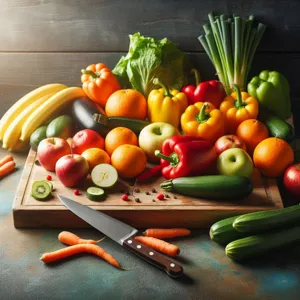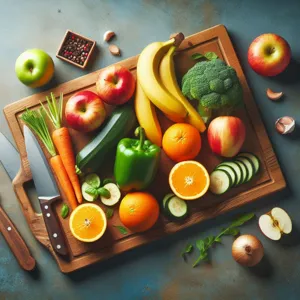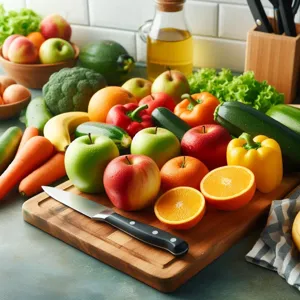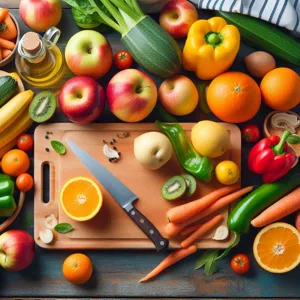In a world where food waste is a growing concern, finding inventive ways to use up fruits and vegetables before they spoil has never been more important.
Whether you’ve overestimated your grocery haul or simply have a few forgotten items languishing in the back of your fridge, there’s no need to toss them in the trash. With a splash of creativity and a dash of culinary inspiration, you can transform those soon-to-be wilted greens or overly ripe fruits into delicious meals and snacks that will tantalize your taste buds. In this blog post, we’ll explore a variety of imaginative strategies to repurpose your produce, from vibrant smoothies and hearty soups to preserved delights and creative garnishes. Join us on this flavorful journey to minimize waste while maximizing flavor, and discover how simple it can be to make the most of every last piece of your fresh bounty!
1. Understanding the Importance of Reducing Food Waste

In a world where food waste has become a pressing environmental issue, understanding the significance of reducing waste—especially when it comes to fruits and vegetables—is essential. Each year, millions of tons of produce are discarded, not only squandering the resources that went into growing and transporting them but also contributing to greenhouse gas emissions in landfills. By adopting a mindset focused on minimizing waste, we can make a profound impact on the environment and our wallets.
Fruits and vegetables are often the first to spoil in our kitchens, leaving us grappling with guilt as we toss out wilted greens or overripe bananas. However, recognizing the value of these perishable items can inspire us to think creatively. Not only does reducing food waste benefit the planet, but it also encourages us to maximize our enjoyment of seasonal produce. By finding inventive ways to use up what we have—whether through cooking, preserving, or creative meal planning—we can transform potentially wasted food into delicious dishes and snacks.
Moreover, reducing food waste fosters a greater appreciation for the effort that goes into growing our food. Every fruit and vegetable represents labor, time, and energy, and embracing sustainable practices allows us to honor that investment. Whether it’s by making smoothies from bruised fruits, crafting vegetable stir-fries from leftover produce, or experimenting with homemade sauces and jams, we can take proactive steps to ensure that nothing goes to waste. By understanding the importance of reducing food waste, we not only help the environment but also enrich our culinary experiences, turning what might seem like leftovers into flavorful, nourishing meals.
2. Creative Recipes for Overripe Fruits
When fruits reach the point of overripe, they often get overlooked, but with a dash of creativity, they can transform into delicious culinary delights! Instead of tossing out those soft bananas, spongy peaches, or bruised berries, consider these innovative recipes that not only reduce waste but also add a burst of flavor to your meals.
One of the simplest and most satisfying uses for overripe bananas is in banana bread. The natural sweetness of the fruit enhances the loaf, resulting in a moist, flavorful treat that’s perfect for breakfast or a snack. To elevate it further, add in some chopped nuts, dark chocolate chips, or a sprinkle of cinnamon for a comforting twist.
If you’re dealing with squishy berries, don’t despair! They can be easily transformed into a vibrant berry compote. Just simmer them on the stovetop with a bit of sugar and lemon juice until they break down into a thick syrup. This compote can be drizzled over pancakes, stirred into yogurt, or even used as a topping for ice cream, making it a versatile addition to your dessert repertoire.
And let’s not forget about those overly ripe tomatoes! Instead of discarding them, why not whip up a rich tomato sauce? Simply sauté garlic and onions, add in your tomatoes, and let it simmer until it thickens. This sauce can serve as a base for pasta dishes, pizza, or even a savory soup, bringing depth and flavor to your meals.
By thinking outside the box and embracing your overripe fruits, you can not only enjoy a variety of delectable dishes but also contribute to a more sustainable kitchen. So the next time you find yourself with a collection of fruits on the verge of spoilage, remember these creative recipes and turn potential waste into delightful meals!
3. Delicious Ways to Use Wilting Greens

Wilting greens, often seen as the unfortunate remnants at the bottom of your crisper drawer, can actually be transformed into a variety of delicious dishes that will not only minimize waste but also maximize flavor. Instead of tossing those limp leaves into the compost, consider how they can elevate your meals.
One of the simplest and most satisfying ways to use wilting greens is to whip up a vibrant pesto. Blend together your greens—be it spinach, kale, or even arugula—with garlic, nuts, olive oil, and a sprinkle of cheese for a creamy, herbaceous spread that pairs beautifully with pasta, sandwiches, or as a dip for fresh veggies. This versatile sauce not only breathes new life into your greens but also allows you to get creative with whatever nuts or cheeses you have on hand.
Another fantastic option is to incorporate these greens into a hearty soup or stew. Sauté them with onions and garlic as the base, then add your choice of broth, protein, and grains. The wilting greens will soften and meld into the dish, infusing it with nutrients and flavor. A rustic minestrone or a comforting lentil soup can be effortlessly enhanced with a handful of wilting spinach or Swiss chard, creating a wholesome meal that’s both filling and nutritious.
For a lighter option, consider a refreshing salad. Even if your greens aren’t at their peak freshness, a zesty dressing can work wonders. Toss your wilting greens with a tangy vinaigrette, add some nuts or seeds for crunch, and include any leftover fruits or veggies you might have. The acidity of the dressing can revive the greens, turning them into a delightful side or main dish.
Finally, don’t underestimate the power of a smoothie! If your greens are too far gone for salads or sautéing, toss them into a blender with some ripe fruit, yogurt, and a splash of juice or milk. The sweetness of the fruit will mask any bitterness, and you’ll end up with a nutrient-packed drink that’s perfect for breakfast or an afternoon snack.
With a little creativity, you can transform wilting greens into a variety of delicious dishes, ensuring that nothing goes to waste and your meals are as flavorful as they are healthy!
4. Making Homemade Smoothies and Juices
When it comes to using up your fruits and vegetables before they spoil, making homemade smoothies and juices is not only a delicious solution but also a fun and creative one! Imagine a colorful, nutrient-packed concoction that not only helps reduce food waste but also boosts your energy and vitality. The beauty of smoothies and juices lies in their versatility; you can mix and match whatever you have on hand, creating unique flavor profiles while ensuring that no produce goes to waste.
start by collecting any overripe fruits, such as bananas, berries, or peaches. These fruits are perfect for smoothies, as their natural sweetness can elevate the taste and texture of your drink. Toss them into a blender with a handful of leafy greens, like spinach or kale, for an added nutritional punch. You can also throw in some yogurt or a splash of milk for creaminess, or opt for a dairy-free alternative like almond or coconut milk. Don’t forget to add ice or frozen fruit to give your smoothie a refreshing chill.
For those who prefer juices, the possibilities are equally exciting. Gather together a mix of hard and soft vegetables—think carrots, cucumbers, and bell peppers paired with apples or citrus fruits for a zesty kick. A juicer can transform these ingredients into a vibrant beverage that retains all the essential vitamins and minerals. Experiment with flavor combinations, such as ginger and beetroot for a spicy-sweet blend, or a refreshing cucumber-mint concoction that screams summer.
Creating smoothies and juices not only helps save your fruits and vegetables from the compost bin but also encourages you to explore new tastes and textures. Plus, it’s a fantastic way to involve the whole family; let kids choose their favorite ingredients and watch as they become excited about healthy eating. So grab your blender or juicer, and get ready to whip up some deliciously nutritious drinks that will keep your produce from going to waste while tantalizing your taste buds!
5. Preserving Fruits and Vegetables: Jams, Jellies, and Pickles

Preserving fruits and vegetables through jams, jellies, and pickles is not just a practical way to prevent spoilage; it’s also a delightful journey into the world of flavor. Imagine transforming an overflowing bowl of ripe strawberries or a bounty of crisp cucumbers into jars of vibrant, homemade delights that can be enjoyed long after the harvest season.
Starting with jams and jellies, the process is both simple and gratifying. By cooking down your favorite fruits with sugar and pectin, you unlock a tapestry of flavors that captures the essence of the fruit at its peak ripeness. Whether it’s the sweet, tangy burst of strawberry-rhubarb jam or the aromatic warmth of spiced peach preserves, each jar becomes a little time capsule of summer’s bounty. Spread these concoctions on warm toast, swirl them into yogurt, or use them as a flavorful filling in desserts.
On the other hand, pickling offers a savory counterbalance and a way to enjoy vegetables in a whole new light. Cucumbers, carrots, radishes, and even green beans can be transformed into crunchy, tangy pickles that bring a zesty kick to any meal. The pickling process can be as simple as combining vinegar, water, salt, and your choice of spices. You can experiment with flavors, adding garlic, dill, or even chili flakes for an extra punch. The result? A colorful array of jars lined up in your pantry, ready to be enjoyed as a snack, a side dish, or a unique addition to salads and charcuterie boards.
Not only does preserving your produce extend its shelf life, but it also encourages creativity in the kitchen. As you experiment with different fruits, vegetables, and flavor combinations, you’ll discover new favorites and perhaps even create signature recipes that friends and family will cherish. Plus, there’s a certain satisfaction that comes from seeing your hard work pay off in the form of beautifully sealed jars, each one a testament to your resourcefulness and culinary spirit. So don’t let your fruits and vegetables go to waste—embrace the art of preserving and savor the flavors of every season!
6. Freezing Techniques for Seasonal Produce
Freezing is a fantastic way to preserve the freshness of your seasonal fruits and vegetables, allowing you to enjoy their vibrant flavors long after their peak season has passed. This method not only extends their shelf life but also minimizes waste, ensuring that you make the most of your harvest. However, mastering the art of freezing requires a few key techniques to maintain the quality and nutritional value of your produce.
Before you freeze, it’s essential to wash and prep your fruits and vegetables properly. For leafy greens like spinach or kale, a quick blanching in boiling water for just a couple of minutes can help retain their color and texture. After blanching, plunge them into ice water to halt the cooking process, then drain and dry thoroughly. This technique works wonders for preserving the crispness of your greens.
For fruits like berries, peaches, or bananas, consider slicing them into manageable pieces before freezing. Spread them out in a single layer on a baking sheet and pop them in the freezer for a couple of hours. This prevents the pieces from clumping together, making it easier to grab just the right amount later on. Once they’re frozen solid, transfer the fruits to airtight containers or freezer bags, ensuring you remove as much air as possible to prevent freezer burn.
When it comes to vegetables with a higher water content, like zucchini or cucumbers, you might want to sauté or roast them slightly before freezing. This helps eliminate excess moisture and enhances their flavor, making for a more delicious dish when you finally pull them out of the freezer months later.
Label your containers with the date and type of produce to keep track of what you have and ensure you use them within their best timeframe. With these freezing techniques in your arsenal, you can savor the taste of summer all year round, turning your seasonal bounty into delicious smoothies, soups, and stir-fries whenever the craving strikes!
7. Crafting Flavorful Soups and Stocks

Crafting flavorful soups and stocks is one of the most rewarding ways to use up fruits and vegetables before they spoil. Not only does this method reduce waste, but it also allows you to create hearty, nutritious meals that can be enjoyed at any time. Embrace the art of soup-making by gathering those slightly overripe tomatoes, wilting greens, or leftover herbs that may not be as crisp as they once were.
Start by chopping your ingredients into bite-sized pieces and sautéing them in a pot with a drizzle of olive oil. As the vegetables soften, their natural sugars caramelize, releasing a sweet and savory aroma that fills your kitchen. Next, add water or stock—homemade, if you have it on hand—to cover the veggies, along with a sprinkle of salt and pepper to enhance the flavors. For an extra depth of taste, toss in any leftover bones or meat scraps you might have; they will impart a richness that elevates your creation.
Let your concoction simmer gently, allowing all the flavors to meld together. If you’re making a stock, this process can take several hours, but the end result is worth the wait—an aromatic base that can be used in countless recipes or enjoyed on its own. For soups, you can blend the mixture for a creamy texture or leave it chunky for heartiness. Add grains like rice or quinoa for added texture and nutrition, or finish with a splash of citrus juice for brightness.
The beauty of soup lies in its versatility, so don’t hesitate to get creative! Incorporate spices, nuts, or even a dollop of yogurt or sour cream for a finishing touch. The possibilities are endless, and the satisfaction of transforming near-spoiled produce into warm, comforting meals will not only delight your palate but also make you feel good about reducing food waste. So, gather those last bits of produce and let your culinary creativity flow—your taste buds (and your wallet) will thank you!
8. Transforming Leftover Veggies into Stir-Fries
Transforming leftover veggies into stir-fries is one of the most satisfying and delicious ways to breathe new life into your produce before it hits the compost bin. This versatile cooking method allows you to mix and match whatever you have on hand, creating a colorful and nutritious dish that highlights the natural flavors of your vegetables.
Imagine a vibrant medley of bell peppers, broccoli, and snap peas sizzling in a hot pan, their colors bright and inviting. Start by chopping your leftover vegetables into bite-sized pieces, ensuring they’ll cook evenly and absorb all the savory goodness of your chosen seasonings. A splash of soy sauce, a hint of garlic, and a sprinkle of sesame oil can elevate your stir-fry to new heights, transforming simple leftovers into a gourmet meal.
Don’t be afraid to get creative! Toss in some chopped onions or garlic for an aromatic base, or add a handful of mushrooms for an earthy depth. If you have any wilting greens, like spinach or kale, throw those in at the last minute for a burst of color and nutrients. You can even incorporate leftover cooked grains, such as rice or quinoa, to make your stir-fry more filling and wholesome.
For a protein-packed twist, consider adding tofu, tempeh, or leftover chicken. As everything cooks together, the flavors meld, creating a dish that not only tastes great but also makes use of what you already have in your fridge. The best part? Stir-fries are quick to prepare, making them a perfect weeknight dinner option.
So the next time you find yourself with a fridge full of forgotten vegetables, remember: a quick stir-fry can turn your leftovers into a culinary masterpiece, showcasing the vibrant tastes of fresh produce while minimizing waste. Embrace the creativity of cooking and enjoy the delicious results!
9. Baking with Fruits: Muffins, Cakes, and Breads
Baking with fruits is not only a delicious way to use up produce before it spoils, but it also adds a delightful twist to your favorite baked goods. Think beyond the standard banana bread or apple pie; the possibilities are endless! Overripe bananas can be mashed into moist muffins or blended into a rich, creamy cake batter that transforms a simple dessert into a flavorful experience. Similarly, berries that are just shy of perfect can be folded into a fluffy cake, providing bursts of sweetness and tartness with every bite.
Consider experimenting with seasonal fruits like peaches or plums, which can be chopped and nestled into a buttery crumb cake, creating a perfect balance of flavors. For a unique twist, try incorporating vegetables like shredded zucchini or carrots, which not only add moisture but also pack a nutritional punch. A carrot cake spiced with cinnamon and topped with cream cheese frosting is a classic that never disappoints!
Don’t forget about quick breads, which are incredibly forgiving and adaptable. Mix in some diced strawberries or blueberries to elevate your standard loaf, or try a savory version by adding grated zucchini or even pumpkin puree to create a hearty, satisfying bread.
Beyond flavor, baking with fruits and vegetables allows you to immerse yourself in a creative process that can be very rewarding. The vibrant colors and natural sweetness of the produce make for beautiful presentations, whether you’re baking for a special occasion or just treating yourself to a homemade delight. So the next time you find yourself with a surplus of fruits or vegetables, grab your mixing bowl and whisk away—your kitchen is about to become a haven for mouthwatering, wholesome treats!
10. Innovative Salads: Using Up Extra Produce
When it comes to utilizing those extra fruits and vegetables before they spoil, innovative salads can be a delightful and delicious solution. Think beyond the classic lettuce base; let your creativity run wild by incorporating a variety of textures, colors, and flavors that will not only elevate your meal but also make good use of your surplus produce.
Start with a base that suits your mood. Instead of traditional greens, consider using shredded cabbage for a crunchier texture, or quinoa for a protein-packed foundation. Add in an array of colorful vegetables—diced bell peppers, shredded carrots, or even roasted sweet potatoes can add both taste and visual appeal.
Now, let’s talk about the fruits! Slices of ripe peaches or juicy strawberries can bring a refreshing sweetness to your salad, while avocados add creaminess and healthy fats. For an extra burst of flavor, toss in some herbs like fresh mint or basil, which can complement your ingredients beautifully.
Don’t forget about the dressings! Whip up a zesty vinaigrette using olive oil, balsamic vinegar, and a splash of citrus juice. Or, try a yogurt-based dressing for a creamy, tangy twist. The key is to experiment—mix and match your veggies and fruits, and don’t shy away from unusual pairings. You might just stumble upon a winning combination that becomes a new favorite.
Finally, consider adding some protein to make your salad a complete meal. Grilled chicken, chickpeas, or even nuts and seeds can provide that satisfying element while ensuring you’re not wasting any of your produce. By crafting innovative salads, you not only clear out your fridge but also treat yourself to fresh, vibrant meals that are as nutritious as they are delicious. So, grab those fruits and veggies, and let your culinary imagination soar!
11. Fermentation: A Fun Way to Preserve Vegetables
Fermentation is not only a time-honored method of food preservation but also a delightful culinary adventure that can breathe new life into your surplus vegetables. This age-old technique transforms fresh produce into tangy, probiotic-rich foods that can enhance your meals and boost your gut health.
To get started, gather your freshest vegetables—think crunchy cucumbers, vibrant carrots, or hearty cabbage. The process is surprisingly simple and requires just a few basic ingredients: your chosen veggies, salt, and water. The salt acts as a natural preservative, drawing out moisture and creating an anaerobic environment that encourages beneficial bacteria to thrive while inhibiting the growth of harmful pathogens.
Once you’ve chopped your vegetables and mixed them with the salt, pack them tightly into a clean jar, ensuring that they are fully submerged in their own brine. This is crucial for successful fermentation. You can add spices, garlic, or herbs for an extra burst of flavor, making each batch uniquely your own.
Seal the jar and let it sit at room temperature for anywhere from a few days to several weeks, depending on your taste preference. As the days go by, you’ll notice the tangy aroma developing, signaling that fermentation is in full swing. Taste your veggies periodically; once they’ve reached your desired level of sourness, transfer them to the fridge to slow down the fermentation process.
Not only does fermentation extend the shelf life of your produce, but it also opens up a world of culinary possibilities. Enjoy your tangy pickles as a zesty addition to sandwiches, toss fermented carrots into salads for an unexpected kick, or savor a spoonful of kimchi alongside your favorite dishes. With fermentation, you can turn near-spoiled vegetables into delicious, healthy staples that will keep your meals exciting and your pantry stocked!
12. Creative Garnishes and Snacks from Scraps
One of the most sustainable and inventive approaches to using up fruits and vegetables is to transform their scraps into delightful garnishes and snacks. Instead of tossing those leftover peels, stems, and cores into the compost bin, think creatively about how to repurpose them into something delicious and visually appealing.
Start with citrus fruits like oranges, lemons, and limes. The peels can be transformed into candied zests or infused into syrups for a burst of flavor in cocktails and desserts. Simply simmer the peels in sugar and water until they become tender, then dry them for a sweet, tangy snack or garnish that adds a pop of color to any dish.
Vegetable scraps are equally versatile. Carrot tops, for example, can be blended into a vibrant pesto, adding a peppery kick to pasta dishes or sandwiches. Similarly, beet greens can be sautéed with garlic and olive oil for a nutritious side that highlights the often-overlooked parts of the plant.
For a crunchy snack, consider making vegetable chips from kale stems or potato peels. Toss them in olive oil and your favorite seasonings, then bake until crispy for a guilt-free treat that satisfies your craving for something crunchy.
Don’t forget about herbs! Stems from parsley, cilantro, or basil can be blended into dressings or marinades, ensuring that no part of the plant goes to waste.
By getting creative with your scraps, you not only minimize food waste but also discover exciting new flavors and textures that can elevate your meals. So next time you’re preparing a dish, think about those remnants as an opportunity for culinary innovation rather than just waste. Your taste buds—and the planet—will thank you!
13. Meal Prep Ideas to Maximize Fresh Produce Use
Meal prepping is a fantastic way to ensure you make the most of your fresh fruits and vegetables before they spoil, and it can also save you time during busy weekdays. By dedicating a few hours each week to prepare meals in advance, you can create a variety of dishes that not only preserve the integrity of your produce but also keep your meals exciting and flavorful.
Start by assessing the fruits and vegetables on hand. Once you have a clear inventory, plan meals around these ingredients. For instance, if you have an abundance of ripe tomatoes, consider whipping up a hearty tomato sauce or a refreshing salsa. Chopped vegetables can be roasted and stored in the fridge to add to salads, grain bowls, or wraps throughout the week.
Another clever idea is to create smoothie packs. Pre-portion fruits like bananas, berries, and spinach into freezer bags so you can blend a nutritious smoothie in minutes. This not only prevents your produce from going to waste but also ensures you have a quick, healthy option ready to go.
Don’t forget about soups and stews — they’re perfect for using up a variety of vegetables. Simply chop up what you have, sauté them with some aromatics, add broth, and let it simmer. You’ll have a delicious meal that can be frozen in individual portions for later enjoyment.
Lastly, consider making homemade sauces or dips, such as pesto from wilting basil or a zesty guacamole from overripe avocados. These versatile condiments can elevate any meal and ensure that no morsel goes uneaten.
By incorporating these meal prep ideas, you can turn your fresh produce into delectable dishes while maximizing their use and minimizing waste. It’s a win-win for your kitchen and your taste buds!
14. Composting: A Sustainable Way to Deal with Spoiled Food
When it comes to managing spoiled fruits and vegetables, composting emerges as a champion of sustainability. Instead of tossing those overripe bananas or wilting greens into the trash, consider giving them a second life through composting. This eco-friendly practice not only reduces food waste but also enriches your garden soil, creating a productive cycle that benefits both your plants and the environment.
Composting is simple and can be done even in small spaces. Start by gathering your spoiled produce—think peels, cores, and any parts that are no longer edible. You can mix these scraps with other compostable materials like coffee grounds, eggshells, and yard waste. The combination of nitrogen-rich green materials (like your fruits and veggies) and carbon-rich brown materials (such as dried leaves or cardboard) will help create a balanced compost pile.
As the microorganisms in your compost work their magic, they will break down the organic matter, transforming it into nutrient-rich compost that can be used to nourish your plants. The result is a dark, crumbly substance that improves soil structure, enhances moisture retention, and provides essential nutrients for your garden.
Moreover, composting reduces the volume of waste sent to landfills, which is beneficial for our planet. By composting spoiled food, you’re actively participating in a sustainable practice that helps close the loop on food production and consumption. So, the next time you find your fruit bowl overflowing with too-ripe produce, remember that composting isn’t just a way to dispose of waste—it’s an opportunity to contribute to a healthier environment while ensuring your garden flourishes. Embrace composting as a creative and responsible solution to food spoilage, and watch your garden thrive while you minimize your ecological footprint!
15. Tips for Storing Fruits and Vegetables to Extend Freshness
Proper storage is essential for extending the freshness of your fruits and vegetables, ensuring that you get the most out of your produce while minimizing waste. Here are some practical tips to help you store your ingredients effectively:
1. **Know Your Produce**: Different fruits and vegetables have different storage needs. For example, apples emit ethylene gas, which can hasten ripening in other produce. Store them separately from other fruits and vegetables to prolong their shelf life. Conversely, bananas should be kept at room temperature until they’re ripe, after which they can be refrigerated to slow down further ripening.
2. **Temperature Matters**: Most vegetables last longer in the refrigerator, but some, like tomatoes and potatoes, do best in a cool, dark place. Keep leafy greens in airtight containers with a damp paper towel to maintain moisture while preventing wilting. For root vegetables, a breathable bag in a cool, dark pantry can do wonders.
3. **Humidity Control**: Different fruits and vegetables thrive in different humidity levels. Consider using the crisper drawers in your fridge wisely; the high-humidity drawer is ideal for vegetables like carrots and broccoli, while the low-humidity drawer works best for fruits like apples and pears.
4. **Use Airtight Containers**: Investing in airtight containers can help maintain the freshness of cut fruits and vegetables. They minimize exposure to air, which can lead to spoilage. For herbs, consider placing them in a glass of water, covering them with a plastic bag, and storing them in the fridge to keep them vibrant and fresh.
5. **Keep It Clean**: Before storing fruits and vegetables, ensure they are clean and completely dry. Excess moisture can lead to mold and rot. A quick rinse followed by thorough drying can help extend their shelf life significantly.
6. **Regular Checks**: Make it a habit to check your produce regularly. Remove any items that show signs of spoilage to prevent them from affecting the freshness of others. Keeping your fridge and pantry organized will make this task easier and more efficient.
By implementing these storage tips, you can savor your fruits and vegetables at their peak freshness, enjoy their flavors longer, and reduce the frustration of finding spoiled produce at the back of your fridge. With a little care, you can ensure that your kitchen remains a vibrant haven for healthy eating!






